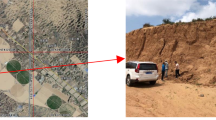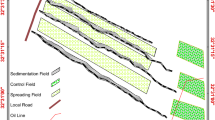Abstract
Depended on the analysis of ground snow situation, soil moisture loss speed and soil structure after planting crops of Mu Us Sandy Land remedied with feldspathic sandstone in the fallow period, it is concluded that feldspathic sandstone mixed with sand improved the sand stabilization in the governance of Mu Us Sandy Land in the fallow period. The sandy land remedied with feldspathic sandstone had big snow coverage, 25%–75% higher than normal sand; soil moisture losses slowed down, and moisture content rose by over 3 times; soil structure had been improved, and water stable aggregate content increased by 6.52%–18.04%; survival rate of protection forest increased to 85%; and ground flatness is less than 1%. The above conditions weakened sand rising conditions of Mu Us Sandy Land in the fallow period and formed two protective layers of snow cover and soil frozen layer under cold weather so as to prevent against wind erosion.
Similar content being viewed by others
References
Bao Yuhai, He Xiubin, Yang Jihua et al., 2007. Study on preventing effect of three farmland shelter-forest network on soil wind erosion. Journal of Soil and Water Conservation, 21(2): 5–8. (in Chinese)
Dong Zhibao, Qian Guangqiang, 2007. A review on effect of soil moisture on wind erosion threshold velocity. Acta Pedologica Sinica, 44(5): 934–942. (in Chinese)
Fuh Bawpuh, 1958. The influence of slope on the sunniness. Journal of Nanjing University (Natural Sciences), (2): 23–46.
Han Jichang, Xie Jiancang, Zhang Yang, 2012. Potential role of feldspathic sandstone as a natural water retaining agent in Mu Us Sandy land, northwest China. Chinese Geographical Science, 22(5): 550–555.
Han Jichang, Zhang Yang, 2014. Land policy and land engineering. Land Use Policy, 40: 64–68.
Jiang Deming, Cao Chengyou, Toshio Oshida et al., 2008. Study on the effects of protection against wind, sand-fixation and soil improvement of Caragana microphylla plantations in Horqin sand land. Arid Zone Research, 25(5): 653–658. (in Chinese)
Kong Dezhen, 1996. The ecological economic principle for comprehensive development and management of Maowusu sandland. Pratacultural Science, 13(3): 13–15. (in Chinese)
Liu Xiaoping, Dong Zhibao, 2002. Wind threshold shear velocities of sands at moistened state. Bulletin of Soil and Water Conservation, 22(2): 1–4, 61. (in Chinese)
Liu Yansui, Fang Fang, Li Yuheng, 2014. Key issues of land use in China and implications for policy making. Land Use Policy, 40: 6–12.
Liu Yansui, Yang Ren, Li Yuheng, 2013. Potential of land consolidation of hollowed villages under different urbanization scenarios in China. Journal of Geographical Sciences, 23(3): 503–512.
Liu Yansui, Zhang Yanyu, Guo Liying, 2010. Towards realistic assessment of cultivated land quality in an ecologically fragile environment: A satellite imagery-based approach. Applied Geography, 30(2): 271–281.
Shen Xiangdong, Zou Chunxia, 2005. Characteristic of wind-sand movement on bare tillage. Journal of Agro-environmental Science, 24(5): 909–912. (in Chinese)
Tai Xianwu, Wu Jingyun, Zhang Xiuyan et al., 2004. Experiment of poplar shelterbelt-forest afforestation sandy land. Protection Forest Science and Technology, 3: 13–14. (in Chinese)
Wang Yuanchang, Wu Yonghong, Kou Quan, 2007. Definition of arsenic rock zone borderline and its classification. Science of Soil and Water Conservation, 5(1): 14–18. (in Chinese)
Wu Jianjun, Sun Huanqing, He Lihong, 2010. Factors influencing threshold wind velocity of sand particles. Journal of Desert Research, 30(4): 743–748. (in Chinese)
Yan F, Wu B, Wang Y J, 2013. Estimating aboveground biomass in Mu Us Sandy Land using Landsat spectral derived vegetation indices over the past 30 years. Journal of Arid Land, 5(4): 521–530.
Ye Hao, Shi Jiansheng, Wang Guiling, 2006. Effect of chemical compositions of Pisha sandstone on the gravity erosion. Hydrogeology & Engineering Geology, 6: 5–8. (in Chinese)
Author information
Authors and Affiliations
Corresponding author
Additional information
Foundation: The public welfare scientific research of Ministry of Land and Resources, No.201411008
Author: Han Jichang (1966–), Professor, specialized in land engineering, land economy, and allocation of land and water resources.
Rights and permissions
About this article
Cite this article
Han, J., Liu, Y. & Zhang, Y. Sand stabilization effect of feldspathic sandstone during the fallow period in Mu Us Sandy Land. J. Geogr. Sci. 25, 428–436 (2015). https://doi.org/10.1007/s11442-015-1178-7
Received:
Accepted:
Published:
Issue Date:
DOI: https://doi.org/10.1007/s11442-015-1178-7




